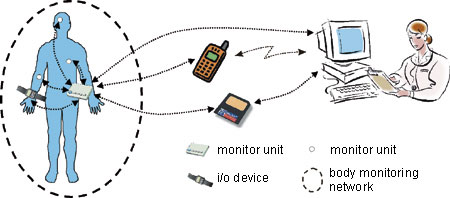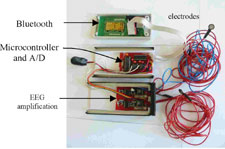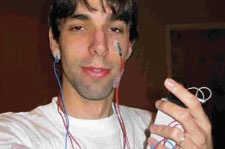 This issue in pdf Archive: |
|
|||||||
A Body-Monitoring System with EEG and EOG Sensorsby Mária Bieliková A team of four students from the Slovak University of Technology in Bratislava has developed a prototype mobile sleep laboratory - a body-monitoring system with EEG and EOG sensors. The students explored the concept of intelligent data collection from human body sensors, and with this system, won third prize at the annual IEEE Computer Society International Design Competition (CSIDC 2002) World Finals. The Body-Monitoring System (BMS) is designed as a mobile device that is able to collect measured data and to act according to instructions set by a supervisor. The system consists of a body-monitoring network (see Figure 1). In order to recognise the monitored person's state, the monitor unit connects to various body sensors and i/o devices using either wired or wireless communication technologies. Data from all sensors is collected, stored and analysed in real time and, according to the analysis, actions may then be performed. A computer is used as an interface to the body-monitoring network, and developed software allows a supervisor to configure the monitor unit for the monitored person, to connect sensors and i/o devices, define and upload instructions for monitoring and download collected data.
The monitor unit software consists of a communication module (responsible for connecting and controlling sensors, and for gathering and pre-processing measured data), a storage module (for storage of collected data), and a policy interpretation module (responsible for controlling the behaviour of the monitor unit according to instructions defined by a supervisor). Two types of drivers are introduced. The role of a communication driver is to hide the way in which data is transmitted. There is one driver for every type of communication interface, eg a Bluetooth driver or an IEEE 802.11b driver. The communication driver does not care about the data itself; this is the role of device drivers. Each type of sensor has its own device driver. When a device driver receives a message from one of its sensors it decodes the message and informs the policy engine about the state of the sensor. To send/receive a message to/from a sensor, the device driver uses the corresponding communication driver. The behaviour of the monitor unit is controlled by interpretation instructions defined by a supervisor (called policies). A policy describes the monitor unit's response to events reported by sensors. Policies are written in the Policy Markup Language (based on XML). It enables general policies to be written using 'virtual' objects that are replaced by physical devices in actual runtime. The monitor unit prototype is implemented in Microsoft-embedded Visual C++ 3.0 on Compaq iPaq Pocket PC HR3870. To validate the system design the students tested it in a specific field of medicine - sleep research. To cope with the problem of sleep disorders, sleep laboratories in hospitals are used to monitor patients overnight. However, patients are influenced by the hospital environment, and usually show different sleep patterns to patients at home. As a solution to this problem a prototype mobile sleep laboratory was developed for home use. The prototype employs an electroencephalograph (EEG, which monitors brain waves), an electrooculograph (EOG, which monitors eye movement) and a thermometer. Analysis of EEG and EOG data allows identification of all sleep stages. Sensor implementation goes out from a common sensor platform designed in the course of this project. The common platform contains a detecting element, amplifiers and filters, an AD converter, a microprocessor and a Bluetooth module. Figure 2 depicts the EEG sensor prototype. The developed EEG sensor could also be used for continuous EEG examination. Such an examination is necessary for patients suffering from epilepsy. The most distinctive features of the described project are:
Although the students concentrated on monitoring the human body for medical purposes, the design of the Body-Monitoring System could also be used in many other fields (eg pulse rate monitoring in sports science, prevention of Sudden Infant Death Syndrome and monitoring of people working in dangerous environments).
Acknowledgement Link: Please contact: |
|||||||




